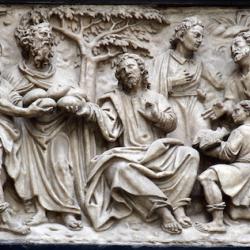In a 1986 article in Semeia , Jerome Neyrey examines the role of purity in Mark’s gospel against the background of Mary Douglas’s work. Importantly, he emphasizes that, while Mark shows how Jesus transgresses the boundaries of purity, he also shows that Jesus is the “Holy One” who has come to refound Israel’s holiness system on a new basis:
“While Mark presents Jesus challenging the Jewish purity system, he also describes him as reforming it in favor of other core values. He is ‘the Holy One of God’ and agent of God’s reform: he is authorized to cross lines and to blur classifications as a strategy for a reformed covenant community which is more inclusive than the sectarian synagogue. As God’s agent of holiness, Jesus makes sinners holy and the sick whole. Yet he draws clear lines between those in his group and those outside, setting up distinguishing criteria for membership and for exclusion in the reformed covenant community.”
Not only do the demons hail Jesus as the “Holy One,” but God Himself testifies that Jesus pleases Him, and John says that he is unworthy to approach and touch the feet of Jesus. Mark begins his gospel, then, with multiple indicators that Jesus is holy.
Yet, it is clear almost immediately that Jesus does not adhere to purity as the Jews understand it: “people with ostensibly excellent purity ratings are Jesus’ most dogged critics.” Neyrey comments, “What would purity-minded people object to about Jesus in Mark’s gospel? Just about everything Jesus did!” And he lists a number of them: Jesus touched lepers, was touched by a menstruating woman, called an “unclean” publican to be among His disciples, traveled in Gentile territory, had contact with Gentiles, including women, the Syro-Phoenician woman, touched the blind, lame, and deaf. He made contact with all sorts of the wrong folks.
Even while he transgressed the boundaries of the social body, he flouted the boundaries of the personal body: He didn’t guard “his bodily orifices or their emissions” but instead disregarded dietary laws, shared meals with sinners, did not wash his hands before eating, used his own spit to heal a blind man and a dumb person, shows no concern for the purity of people in the crowds that he fed.
He disregarded holy times by violating the Sabbath (at least as the Pharisees saw things), showed no respect for the holy place of the temple, disrupting the operations of the temple, and condemning the house.
For all this, Mark still wants to prove the rightness of Jesus high “purity rating,” the theme at the opening of the gospel He does this in various ways. Jesus does not become unclean even when he touches the unclean. Instead of contracting uncleanness, he “imparts cleanness or wholeness to them.” He is authorized by God to be a “limit breaker,” one who is authorizes “to break taboos and cross prohibited boundaries.” Even death, the ultimate defiler, cannot holy Jesus. Rather, Jesus’ death is a means for purification.
For His disciples, Jesus redefines purity around the basic commandments of God. In place of separation, Jesus highlights mercy. The Pharisees and Sadducees establish a purity system with a strongly exclusive orientation, but Jesus’ purity system is open. The Jewish purity system is defensive, while Jesus’ is missional. Jesus’ new purity system deals with many of the concerns that animated the Pharisees, but they are all transformed. He is equally interested in entry requirements, but stresses repentance rather than ritual washings. He is as interested in boundaries as the Pharisees, but the boundaries are not ethnic. Neyrey nicely shows that the refusal of Jewish purity regulations in the church actually fulfills one of the main functions of the purity system, that is, the function of creating a boundary line between the inside and outside. Jews keep dietary rules, the disciples don’t; Jews wash hands, the disciples don’t; Jewish worship centers on the temple and its bloody sacrifice, while the disciples gather for Eucharistic meals in houses.















